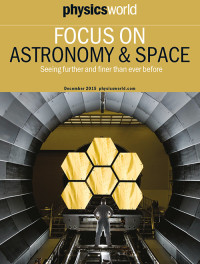By Louise Mayor
 Woolly hats are being donned and there’s a nip in the air as the longest night of the year in the Northern hemisphere approaches. All this darkness makes it the perfect season to gaze up at the stars, planets and puffy nebulae above. But binoculars and amateur telescopes can only enhance the view by so much. To really push the boundaries of how far and how fine we can see, we must turn to international telescope projects both on the ground and in space.
Woolly hats are being donned and there’s a nip in the air as the longest night of the year in the Northern hemisphere approaches. All this darkness makes it the perfect season to gaze up at the stars, planets and puffy nebulae above. But binoculars and amateur telescopes can only enhance the view by so much. To really push the boundaries of how far and how fine we can see, we must turn to international telescope projects both on the ground and in space.
To update you on what we think are the most exciting current and future projects we bring you the Physics World Focus on Astronomy and Space, which you can read free of charge in its entirety.
One particularly ambitious imaging effort is described in the article “Portrait of a black hole“, in which Physics World reporter Tushna Commissariat reports on how a group of astronomers plans to take the first-ever image of a black hole. Despite their name, black holes are apparently not black and the Event Horizon Telescope collaboration has already begun pointing a network of ground-based telescopes at its target: Sagittarius A*, the supermassive black hole at the centre of our galaxy.
Peering further into the cosmos as of 2018, the $8.8bn James Webb Space Telescope (JWST) will be sent to the second Lagrange point, where the Earth will shield it from radiation from the Sun and the lit faces of the Earth and Moon, enabling the telescope to image faint infrared signals from distant objects. The downside of such a position, however, is that it is 1.5 million kilometres from Earth, making it far out of reach of servicing missions. As science writer Edwin Cartlidge reports in “The one-shot space telescope“, “That means the upcoming mission will have just one shot at glory. If any major flaw is discovered once it is in space, the telescope will be doomed to mediocrity or worse. As Eric Smith [programme director of the JWST Eric] puts it, ‘Our job is to make sure that is not a discovery we encounter.’.”
Other highlights in the focus issue include:
• Can you be aware when you’re not there? – Felix J Lockman, principal scientist of the Green Bank Telescope at the National Radio Astronomy Observatory in West Virginia in the US, reckons that remote observation at telescopes may not necessarily produce the best research
• The code for better science – Jon Cartwright reports on a recent survey of more than 1100 astronomers, which found that almost half have received little or no software training, despite 90% writing at least some of their own code
• An ALMA adventure – I travel to the Chajnantor desert plateau, high in the Chilean Andes, to visit the 66 radio antennae that make up the Atacama Large Millimeter/submillimeter Array (ALMA)
• Occulting the stars – Liz Kruesi reports on a “starshade” currently being developed that would resemble a giant sunflower floating in space, with the purpose of allowing astronomers to image starlight reflected from exoplanets by cutting the glare from their parent star
• The next big thing – Michael Banks talks to astronomer Julianne Dalcanton about the plans under way for the High Definition Space Telescope – a mission that would be launched in the 2030s to study the atmospheres of Earth-like planets
All full members of the Institute of Physics received a print edition of the focus issue along with their copy of the December issue of Physics World. You can also read the focus issue free of charge on your desktop or on any iOS or Android smartphone or tablet via the Physics World app, available from the App Store and Google Play.
I hope you enjoy the issue and look forward to hearing your thoughts on the topics covered, which you can share with us either by e-mailing pwld@iop.org or by posting your comments below.
Like the delicate Planck instrument sent successfully to one of the Lagrange points, the James Webb Space Telescope has a good chance to reach its Lagrange point and do its assigned work nicely.
Trackback: Physics World 2015 Focus on Astronomy and Space is out now – MyPhysNet